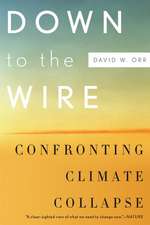Twenty Years of Ozone Decline: Proceedings of the Symposium for the 20th Anniversary of the Montreal Protocol
Editat de Christos Zerefos, G. Contopoulos, Gregory Skalkeasen Limba Engleză Hardback – 2 iun 2009
| Toate formatele și edițiile | Preț | Express |
|---|---|---|
| Paperback (1) | 1225.62 lei 6-8 săpt. | |
| SPRINGER NETHERLANDS – 23 aug 2016 | 1225.62 lei 6-8 săpt. | |
| Hardback (1) | 1234.62 lei 6-8 săpt. | |
| SPRINGER NETHERLANDS – 2 iun 2009 | 1234.62 lei 6-8 săpt. |
Preț: 1234.62 lei
Preț vechi: 1505.64 lei
-18% Nou
Puncte Express: 1852
Preț estimativ în valută:
236.23€ • 246.68$ • 195.08£
236.23€ • 246.68$ • 195.08£
Carte tipărită la comandă
Livrare economică 15-29 aprilie
Preluare comenzi: 021 569.72.76
Specificații
ISBN-13: 9789048124688
ISBN-10: 9048124689
Pagini: 470
Ilustrații: XII, 470 p.
Dimensiuni: 155 x 235 x 23 mm
Greutate: 0.93 kg
Ediția:2009
Editura: SPRINGER NETHERLANDS
Colecția Springer
Locul publicării:Dordrecht, Netherlands
ISBN-10: 9048124689
Pagini: 470
Ilustrații: XII, 470 p.
Dimensiuni: 155 x 235 x 23 mm
Greutate: 0.93 kg
Ediția:2009
Editura: SPRINGER NETHERLANDS
Colecția Springer
Locul publicării:Dordrecht, Netherlands
Public țintă
ResearchCuprins
Opening Ceremony.- Welcome Address.- Statement from the Executive Secretary for the Vienna Convention and the Montreal Protocol.- Opening Address.- Science Inspiring Diplomacy: The Improbable Montreal Protocol.- Keynote Speeches.- Stratospheric Ozone Depletion.- Atmospheric N2O Releases from Biofuel Production Systems: A Major Factor Against “CO2 Emission Savings”: A Global View.- The Long History of Ozone Measurements and the Early Search for Signs of a Trend.- The History of Total Ozone Measurements; the Early Search for Signs of a Trend and an Update.- The Long History of Ozone: Analyses of Recent Measurements.- The Long History of Ozone Measurements: Climatological Information Derived from Long Ozone Records.- Ozone Measurements.- International Multi-Instruments Ground-Based Networks: Recent Developments Within the Network for the Detection of Atmospheric Composition Changes.- International Balloon Measurements for Ozone Research.- The Role of Airborne Science in the Study of Polar Ozone.- Role of Satellite Measurements in the Discovery of Stratospheric Ozone Depletion.- Estimating When the Antarctic Ozone Hole will Recover.- The European Arctic Ozone Campaigns.- Operational Monitoring of the Antarctic Ozone Hole: Transition from GOME and SCIAMACHY to GOME-2.- An Overview of Strategic Ozone Sounding Networks: Insights into Ozone Budgets, UT/LS Processes and Tropical Climate Signatures.- Global Observations—The Key to Model Development and Improved Assessments.- Ozone and Climate-Dynamics.- The Rise and Fall of Dynamical Theories of the Ozone Hole.- Investigations of Climate–Ozone Connections with Coupled Climate–Chemistry Models (CCMs): Another Step Forward.- Stratospheric Ozone Depletion and Tropospheric Chemistry.- Tropospheric Ozone Climate–ChemistryInteraction: Aspects of Climate Changes.- Metrics for Ozone and Climate: Three-Dimensional Modeling Studies of Ozone Depletion Potentials and Indirect Global Warming Potentials.- Stratosphere—Troposphere Interactions in a Chemistry-Climate Model.- Winter Ozone Transport Variations and the Montreal Protocol Impact as Revealed by the Total Ozone Ground-Based Measurements over the Russian Territory in 1973–2005.- Solar Ultraviolet Measurements and Effects.- Solar UV: Measurements and Trends.- Ozone and Ultraviolet Radiation: Informing the Public.- A Contemporary Strategy for Sun Exposure.- Initiatives – Recent Reports.- Findings from the 2006 Ozone Scientific Assessment for the Montreal Protocol.- SPARC Science Supporting the Montreal Protocol.- Industry and the Importance of Science to Business.- How Science Guides Industry Choice of Alternatives to Ozone-Depleting Substances.- The Importance of Chemical Substitutes to Chlorofluorocarbons (CFCs).- Perspectives on the Roles of Science, Scientific Assessments, the Science/Policy Interface and Industry.- The Role of Financial Assistance by the Multilateral Fund in Technology Change to Protect the Ozone Layer.- Conclusion.- Athens Statement.
Textul de pe ultima copertă
This book includes articles presented by leading scientists in the ozone field at the Symposium for the 20th Anniversary of the Montreal Protocol, jointly organized by the United Nations Environment Programme (UNEP), the International Ozone Commission (IO3C), the Academy of Athens and the Mariolopoulos-Kanaginis Foundation, held in Athens in September 2007.
His Excellency Ban Ki-moon, the Secretary-General of the United Nations, recently stated:
"The success of the Montreal Protocol shows us that there are global instruments that can help curb the impact of human activities on the global environment. We should draw lessons from this experience, and strive to replicate it."
This book responds by including the history, science and lessons learned by the application of the Montreal Protocol over the past twenty years. Expressed views come from three Nobel laureates, sixty scientists and representatives of international organizations and industry. Many interesting aspects of ongoing ozone research are also presented, including comparisons of what has been achieved versus what would have been the state of ozone, climate and UV in the environment if the Protocol had never been in use.
His Excellency Ban Ki-moon, the Secretary-General of the United Nations, recently stated:
"The success of the Montreal Protocol shows us that there are global instruments that can help curb the impact of human activities on the global environment. We should draw lessons from this experience, and strive to replicate it."
This book responds by including the history, science and lessons learned by the application of the Montreal Protocol over the past twenty years. Expressed views come from three Nobel laureates, sixty scientists and representatives of international organizations and industry. Many interesting aspects of ongoing ozone research are also presented, including comparisons of what has been achieved versus what would have been the state of ozone, climate and UV in the environment if the Protocol had never been in use.
Caracteristici
Nobel laureates lend their insights to the discussion Discusses diverse topics such as climate-ozone connections and ultraviolet radiation Contains a wealth of information on both historical and current ozone research













